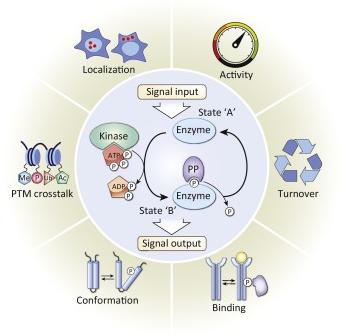Phosphorylation Analysis Service
Protein phosphorylation is the most fundamental, pervasive, and essential mechanism for regulating protein activity and function, present in almost all life processes. Creative Proteomics offers high-quality phosphorylation analysis services, including identification, quantification and characterization, providing valuable insights into your protein research.
What is Phosphorylation
Protein phosphorylation stands as a paramount covalent modification in living organisms, representing the most widespread and extensively researched form of modification. This process entails the transfer of a phosphate group from ATP to amino acid residues of a substrate protein, catalyzed by protein kinases. Typically, the phosphate group attaches to the hydroxyl group of amino acids, predominantly occurring at serine, threonine, and tyrosine residues. Additionally, certain amino and sulfhydryl groups serve as phosphorylation sites.

Fig.1 Schematic of phosphorylation (Pande, A. et al.; 2022)
Phosphorylation, a reversible post-translational modification, intricately regulates various life processes, including cell proliferation, development, differentiation, signal transduction, apoptosis, neural activity, muscle contraction, and tumorigenesis. Serine phosphorylation primarily functions to unfold proteins, activating their viability, while threonine phosphorylation is linked to cell signaling pathways. Tyrosine phosphorylation, beyond contributing to denaturation and activation, imparts a structural cue to binding proteins, facilitating interactions with other proteins to form multiprotein complexes. Reversible phosphorylation is a ubiquitous regulatory mechanism in biology, influencing the majority of proteins. Even when a protein itself remains unphosphorylated, its interactions with other proteins may still be subject to regulation through phosphorylation.
Applications of Phosphorylation Analysis
- Cell Signaling Study
Analyzing protein phosphorylation contributes significantly to cell signaling studies, unraveling the intricacies of signaling pathways. Understanding the dynamics of phosphorylation events helps elucidate how cells respond to various stimuli. - Disease Research
Aberrant protein phosphorylation is associated with numerous diseases, including cancer and neurodegenerative disorders. It aids in identifying altered phosphorylation patterns as potential biomarkers or therapeutic targets. - Drug Development
In drug development, understanding the impact of drugs on protein phosphorylation is crucial. Phosphorylation is involved in a variety of physiological and pathological processes, and analyzing protein phosphorylation contributes to the discovery of drug targets and the study of drug mechanisms.
Our Service
Creative Proteomics has advanced protein detection technologies and can provide customized services to researchers and scientists to help them reveal the complexity of PTM using powerful mass spectrometry technologies. Our protein phosphorylation analysis services include, but are not limited to:
- Serine Phosphorylation Analysis
- Threonine Phosphorylation Analysis
- Tyrosine Phosphorylation Analysis
Workflow of Phosphorylation Analysis

Fig.2 Phosphorylation analysis workflow
- Sample Preparation
Proper extraction and preparation of proteins from biological samples to ensure preservation of phosphorylated proteins. - Phosphorylation Enrichment
Enrichment techniques are employed to isolate phosphorylated proteins or peptides. This step is crucial as phosphorylation modifications are often present in low abundance compared to unmodified proteins. - Detection
WB, protein microarrays and LC-MS/MS are powerful tools for the identification and quantification of phosphorylated peptides, and they provide detection information that facilitates a comprehensive analysis of phosphorylation. - Bioinformatics Analysis
Advanced bioinformatics tools are used to analyze data, identify phosphorylated peptides, and map these modifications to protein sequences. - Result Delivery
After professional data analysis, we deliver results quickly and consistently.
Creative Proteomics brings a wealth of experience to the field of protein research. Our comprehensive services and products cover the entire spectrum of utilizing suitable and efficient gateways. Utilizing our proprietary platform, we have successfully implemented many proteomics research projects. If you are interested, please contact us for more information and a quote.
Reference
- Pande, A.; et al. Phytohormonal Regulation Through Protein S-Phosphorylation Under Stress. Frontiers in Plant Science. 2022, 13: 865542

